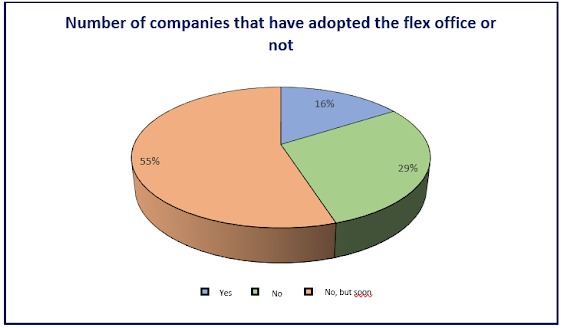The flex
office, the new organization of corporate offices
Antoine PIVERT - LPro QHSSTE 2021-2022
I – Introduction
Hello to
you dear reader,
It's 2022
and you still haven’t heard about the flex office? This article is made for
you. In this article, I’m going to give you an overview of this concept, which
is becoming more and more popular in 21st-century companies.
Firstly, I
will introduce you to its operating principle and its history. Then I will give
you some key figures and finally I will explain the advantages and
disadvantages of this concept while giving you my opinion on the subject.
II - Definition, principle of the concept, history
What is the flex office?
It is an
organisation of workspace based on unassigned workstations. Indeed, this
concept is far from the classic organisation that we can experience in
companies with one workstation per employee.
The flex
office is based on a known statistic. On average, a workstation in a company,
whether in a closed office or an open space, remains occupied between 60 and
80% of the time. Therefore, by making all workstations freely available to any
employee, the company optimizes its workspace.
In contrast
to a traditional organisation, this concept offers a wide variety of
activity-specific workstations. For example, there are meeting rooms, classic
offices, isolated offices (bubbles), confidential rooms (opaque glass and
soundproof), standing desks, project rooms, etc.
This great
diversity allows each employee to choose a workstation that suits him or her,
depending on the task or activity of the day.
In addition to optimizing space and offering a wide variety of workstations, the flex office offers a more pleasant daily environment (break room, cafeteria, relaxation areas, etc.) and more dynamic services.
Before setting up a flex office organisation
This photo
shows a classic organisation of work space with offices partitioned by large
windows
After the implementation of a flex office organisation
This photo shows the organisation of the flex office work space. There is an open space base with different types of offices (classic offices, meeting rooms, project areas) and a relaxation/break area
When
was this concept invente and where?
The concept
of the flex office was invented in the 1980. The idea was developed by Philip
Stone and Robert Luchetti, two professors from Harvard University in the United
States.
Today, work
organisations have been completely overturned by the current COVID-19 health
crisis and by the strong development of start-ups. The concept of the flex
office will become increasingly popular in the years to come.
III - Key figures, statistics
According
to a survey* carried out by Deskeo, a company that creates customised work
space, currently in France 16% of companies have adopted an organisation based
on the flex office concept.
In the
coming years, this figure will increase. Indeed, according to the survey, about
55% of companies would like to switch to a flex office in the near future.
*survey carried out by the company Deskeo among 3978
professionals
IV - Advantages, disadvantages, personal opinion
The
disadvantages of the flex office are :
Organisational
problems within the teams and between the different departments.
Indeed, if communication is not good and a defined internal organisation is not
adopted, then the flex office can lead to great disorder within the company.
Problem of space or office space. If too many employees are working on site on the same day this can cause a problem with the amount of space available. In addition, it can also cause a problem in terms of the types of office space available. For example, if an employee wants to work on a standard desk and there is no more space available on this type of desk, then he/she will have to find another place with a different type of desk (bubble desk, standing desk...).
No
more personalization of the desk. Personal belongings will have
to be stored in lockers.
Less contact with your team. People in the same team will no longer necessarily be side by side in the workspace, or will not be present on site at the same time, which can lead to communication problems, or even a feeling of loss of belonging to a team.
The advantages of this concept are :
A dynamic and flexible environment. The
different types of offices available allow employees to adapt their workspace
according to the tasks they have to perform each day. In addition, the
available layouts allow teams to work in a variety of ways to break the
routine.
A pleasant working environment. Employees benefit from a
workspace designed to improve the QWL Quality
of Work Life maybe Quality
of Work Life?, to maintain the order of the acronym) with relaxation areas,
cafeterias, leisure areas and even rest areas.
Cost reduction. By adopting this type of organisation,
companies considerably reduce their real estate costs.
V - Conclusion
The flex office is a work organisation that cannot be
adopted by all companies. Indeed, it will depend on the sector of activity and
the size of the company.
Moreover, the flex office is not a miracle solution
for increasing productivity and QWL while reducing costs. Therefore, before
adopting this organisation, companies will have to carry out a needs study to
determine whether or not the flex office would be suitable for them.
VI - Bibliography
DESKEO (2021) | [Survey] Flex office:
towards the end of the fixed office | Available at the following URL: https://www.deskeo.com/blog/sondage-flex-office/
GREENWORKING (2019) | Flex office : what ? why ?
how ? A look back at the birth of the office 2.0 | Available at the following
URL: https://www.greenworking.fr/flex-office-quoi-pourquoi-comment-retour-sur-la-naissance-du-bureau-2-0/
UBIQ
MEDIA (2021) | What
is the flex office ? Available at the following URL: https://www.ubiq.fr/blog/quest-ce-que-le-flex-office/
WELCOME
TO THE JUNGLE
(2020) | Flex office: source of well-being or poisoned gift | Available at the
following URL: https://www.welcometothejungle.com/fr/articles/flex-office-travailleurs-nomades







Aucun commentaire:
Enregistrer un commentaire